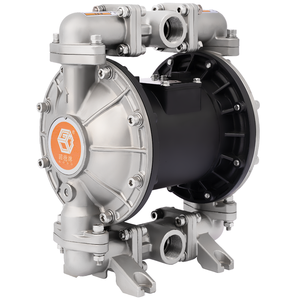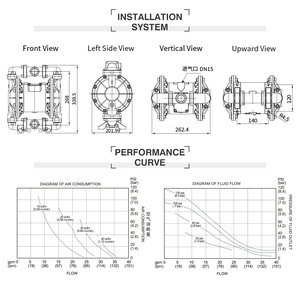
All categories
Featured selections
Trade Assurance
Buyer Central
Help Center
Get the app
Become a supplier

(9 products available)






























A hydrofor water pump, also known as a pressure tank, is a system that contains water and is pressurized by air or gas. The tank has a bladder or diaphragm that separates the water from the air.
There are several types of Hydrofor water pumps, including:
Submersible well pumps
These are highly functional well pumps that can be submerged in water. They are efficient and quiet, making them ideal for residential and irrigation systems that need high water pressure.
Jet well pumps
This is one of the most popular types of well pumps. Jet well pumps are installed above the well and use a jet assembly to move water to the surface. They are suitable for shallow and deep wells.
Centrifugal pumps
These pumps use rotational energy to move water. They are versatile and can be used in various applications, such as irrigation, industrial processes and transferring liquids.
Hand pump
Hand pumps are simple and require no electricity. They are used when well water is needed in emergencies or in areas where there are no other water supply systems.
Solar pumps
These hydrofor water pumps use energy from the sun. They are ideal for remote areas where there is no grid power and are used for various applications, such as irrigation, livestock watering and village water supply.
Vertical turbine pumps
This is a hydrofor water pump designed for deep well applications. They are efficient and can handle high flow rates, making them ideal for large-scale irrigation and industrial use.
Booster pumps
These are pumps that increase water pressure in a system. They are used in high-rise buildings, irrigation systems and industrial processes where consistent pressure is required.
Vacuum pumps
These are pumps that create a vacuum to move or transfer liquids. They are used in applications such as liquid transfer, medical and laboratory uses.
Electric pumps
These are hydrofor water pumps powered by electricity. They are used in various applications, such as water supply, irrigation and industrial processes, providing a reliable and consistent water flow.
Stainless steel pumps
These are pumps made of stainless steel. They are suitable for applications that require high hygiene standards, such as food processing, pharmaceuticals and water treatment.
Multistage pumps
These are hydrofor water pumps with several impellers that increase water pressure and flow. They are used in applications such as boiler feed, water supply and irrigation systems, where high pressure and flow rates are required.
Flow Rate
Hydrofor water pump flow rate is the volume of water pumped per unit of time. Depending on the pump size and application, the flow rate can range from a few liters to thousands of liters per minute.
Head Pressure
The total head is the distance from the water surface to the delivery point. It includes three components: suction head (water from the pump surface), discharge head (water to the pump's pressure), and velocity head (water in the pipe's movement). Hydrofor water pumps create head pressure that overcomes gravity, friction, and system resistance to move water through pipelines.
Power Consumption
Hydrofor water pump power consumption is the amount of energy the pump uses to move water. It is expressed in kilowatts (KW) or horsepower (HP). Hydrofor water pumps have higher power requirements because of their constant pressure delivery and water flow.
Material
Hydrofor water pump components are made from different materials with unique properties that affect their use and lifespan. Common materials include stainless steel, cast iron, and plastic. Each material is suitable for different applications, depending on the pump's corrosion resistance and water temperature.
Pressure
The pressure delivered by the hydrofor water pump is measured in bars or pounds per square inch (psi). Higher pressure pumps are used for applications requiring water delivery at high elevations or through long distances.
Pump Size
Hydrofor water pumps are available in different sizes, each suitable for specific applications. Small pumps are used in domestic and agricultural applications, while large pumps are used in municipal water supply and industrial applications.
Motor
The pump's motor provides the energy necessary for its operation. The motor's size and type are determined by the required flow rate and pressure. Hydrofor water pumps depend on electric motors for operation, although some models use diesel or petrol motors.
Maintaining a hydrofor water pump is vital to ensure efficient operation and increase its lifespan. Here are some general guidelines for maintaining a hydrofor water pump:
Choosing the right Hydrofor water pump can be a daunting task, considering the different models and specifications available.
To help make the right choice, here are some factors to consider:
Firstly, it is important to know the intended use of the water pump. Will it be used for irrigation, residential use, or industrial purposes? Knowing the intended use will help choose a Hydrofor water pump that will meet specific needs.
Another factor to consider is the flow rate and pressure. When choosing a Hydrofor water pump, consider the required flow rate and pressure for specific needs. The water pump's flow rate should match the required water supply, while the pressure should be sufficient to overcome obstacles like elevation or pipe length.
Consider also the source of water when choosing a Hydrofor water pump. Is the water to be pumped from a well, surface water like rivers and lakes, or rainwater harvesting? Different water sources require different types of water pumps.
Additionally, it is important to consider the installation and maintenance of the Hydrofor water pump. Choose a water pump that is easy to install and require minimal maintenance. Also, consider the noise level of the water pump.
Before attempting to repair a hydrofor water pump, it is essential to read the manufacturer's manual to know how to handle it properly. Here are some steps to follow when replacing a hydrofor water pump:
Shut off the power supply
To start with, users should disconnect the water pump from the power supply. This step is important to ensure safety and prevent accidents from happening during the hydrofor water pump installation process.
Drain the water
After draining the water from the system, users can now remove the pipes connected to the old water pump. It is advisable to use towels or rags to soak any remaining water that might leak during the process.
Disconnect the pressure switch
At this stage, the user can now disconnect the pressure switch from the old water pump. This step is important because the pressure switch controls the water pump's on and off functions based on water pressure.
Remove the mounting bolts
To remove the mounting bolts, use a wrench or screwdriver, depending on the type of bolts used to secure the water pump. This step can be a bit challenging because the bolts may be rusted or tightened up. In this case, users can use penetrating oil to loosen them up.
Install the new water pump
Now it's time to install the new water pump into the mounting area. To do this, simply align the water pump with the mounting holes and insert the mounting bolts. Then, users should tighten the bolts securely to avoid any leaks or pump movements.
Reconnect the pressure switch
Once the new water pump has been installed, the user can now reconnect the pressure switch. Make sure the switch is connected to the control panel of the water system. Also, double-check to ensure that all the electrical connections are secure and tight.
Reconnect the pipes
At this stage, users can now reconnect the pipes to the new water pump. Make sure the hydraulic pipes are properly aligned and securely tightened to prevent any leaks. Also, reconnect any other fittings or accessories that were disconnected during the removal process.
Turn on the power supply
Before turning on the power supply, users should double-check to ensure that all the connections, both electrical and hydraulic, are secure and tight. Then, open the water taps to release any air trapped in the system, and finally, turn on the power supply to the hydrofor water pump.
Q1: What is the difference between a hydrofor water pump and a normal water pump?
A1: Hydrofor water pumps are also known as hydrofor or pressure boosting systems. They are designed to supply water with high pressure and consistent flow. They are suitable for applications with high water demand, such as irrigation, fire protection systems, and industrial processes. They also contain water in a pressure tank to ensure water availability and reduce pump cycling. On the other hand, normal water pumps are designed to provide water with a steady flow but not constant pressure and high demand.
Q2: Can a hydrofor water pump be used for irrigation systems?
A2: Yes, a hydrofor water pump can be used for irrigation systems. In fact, it is suitable for irrigation systems that require consistent water pressure and high flow rates, such as drip and sprinkler irrigation systems.
Q3: Can a hydrofor water pump be used for domestic applications like garden watering and car washing?
A3: Yes, a hydrofor water pump can be used for domestic applications. It is overqualified for applications like garden watering and car washing.
Q4: What are the main benefits of using a hydrofor water pump?
A4: The benefits of using a hydrofor water pump include reliable water supply, energy efficiency, low noise operation, and compact design.